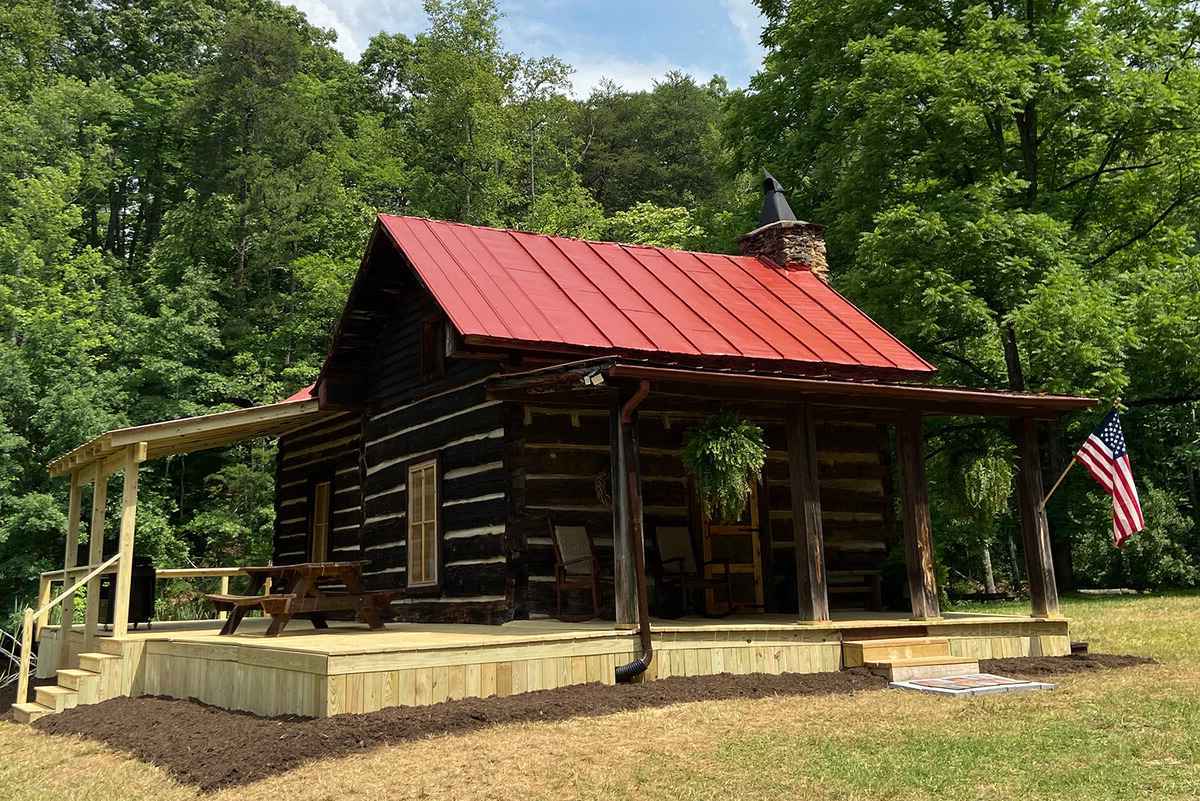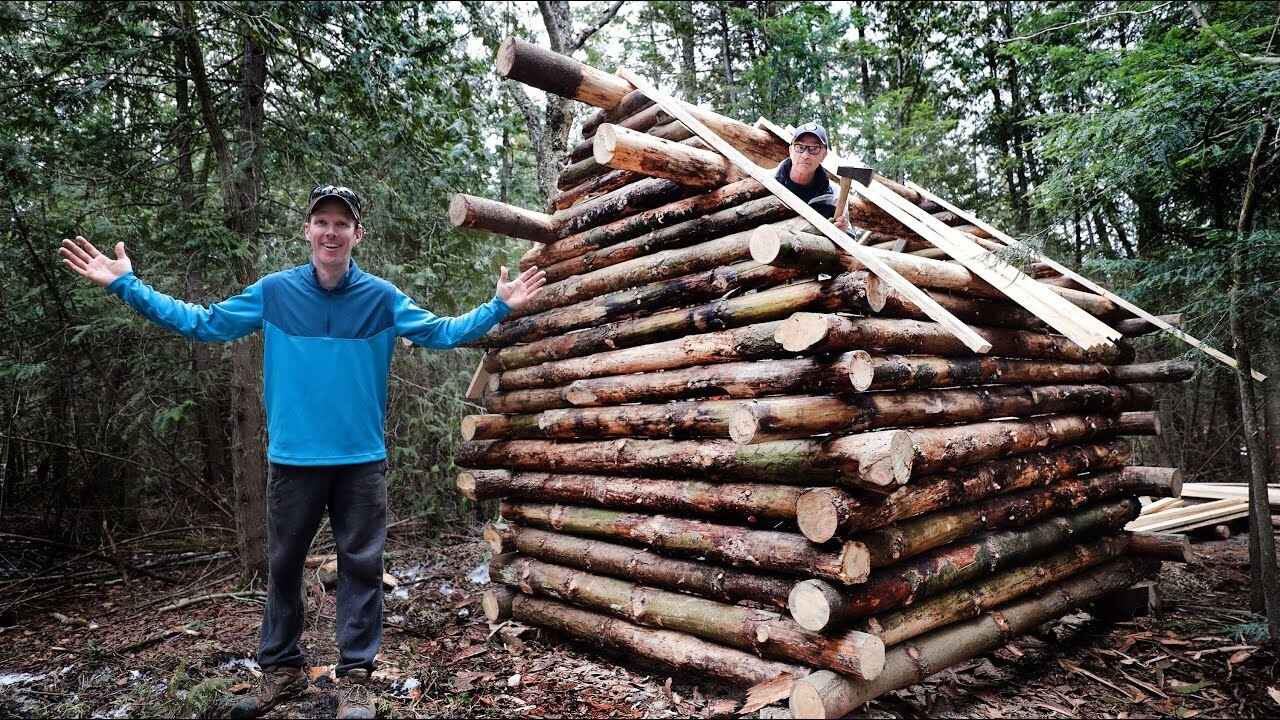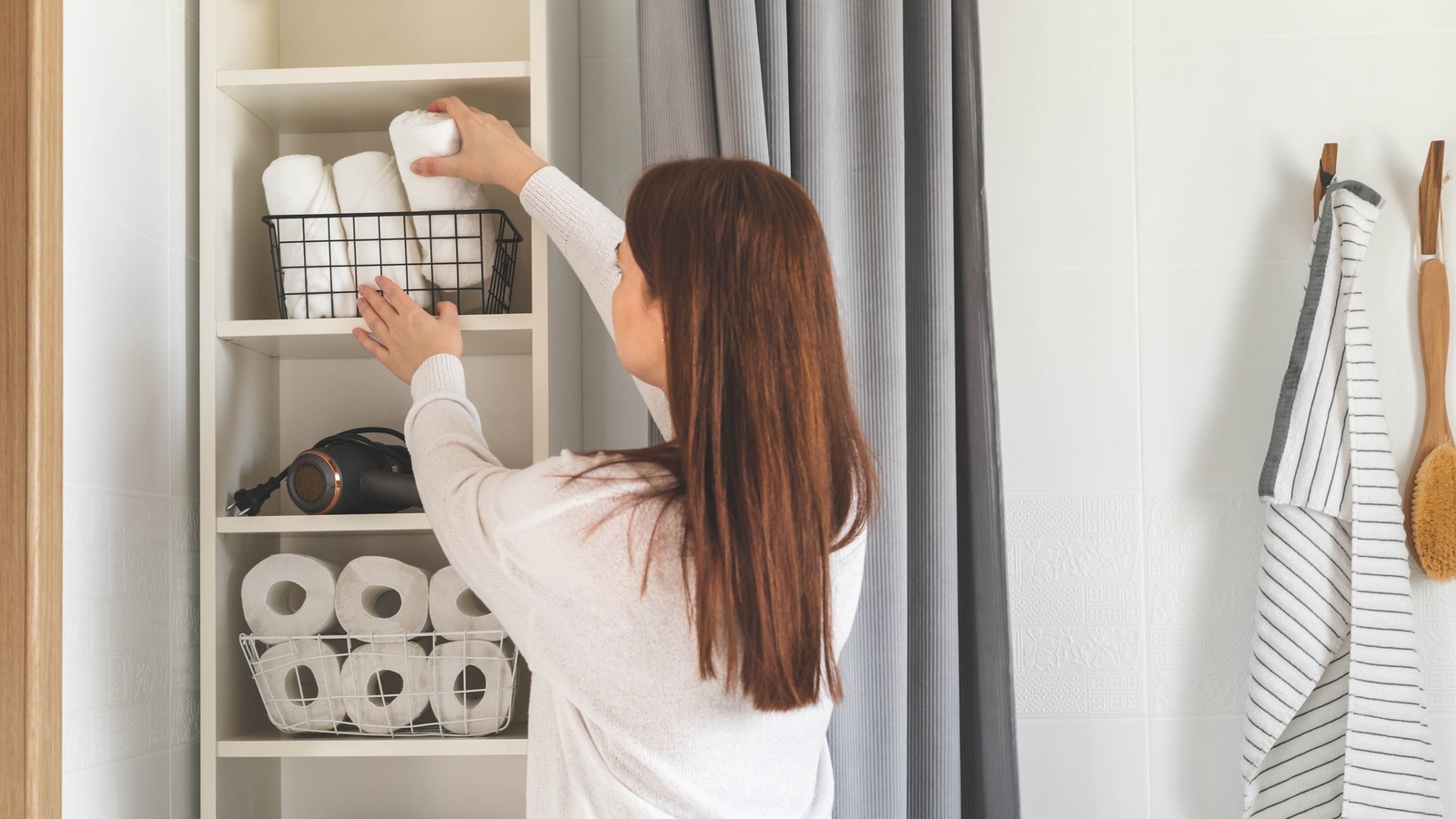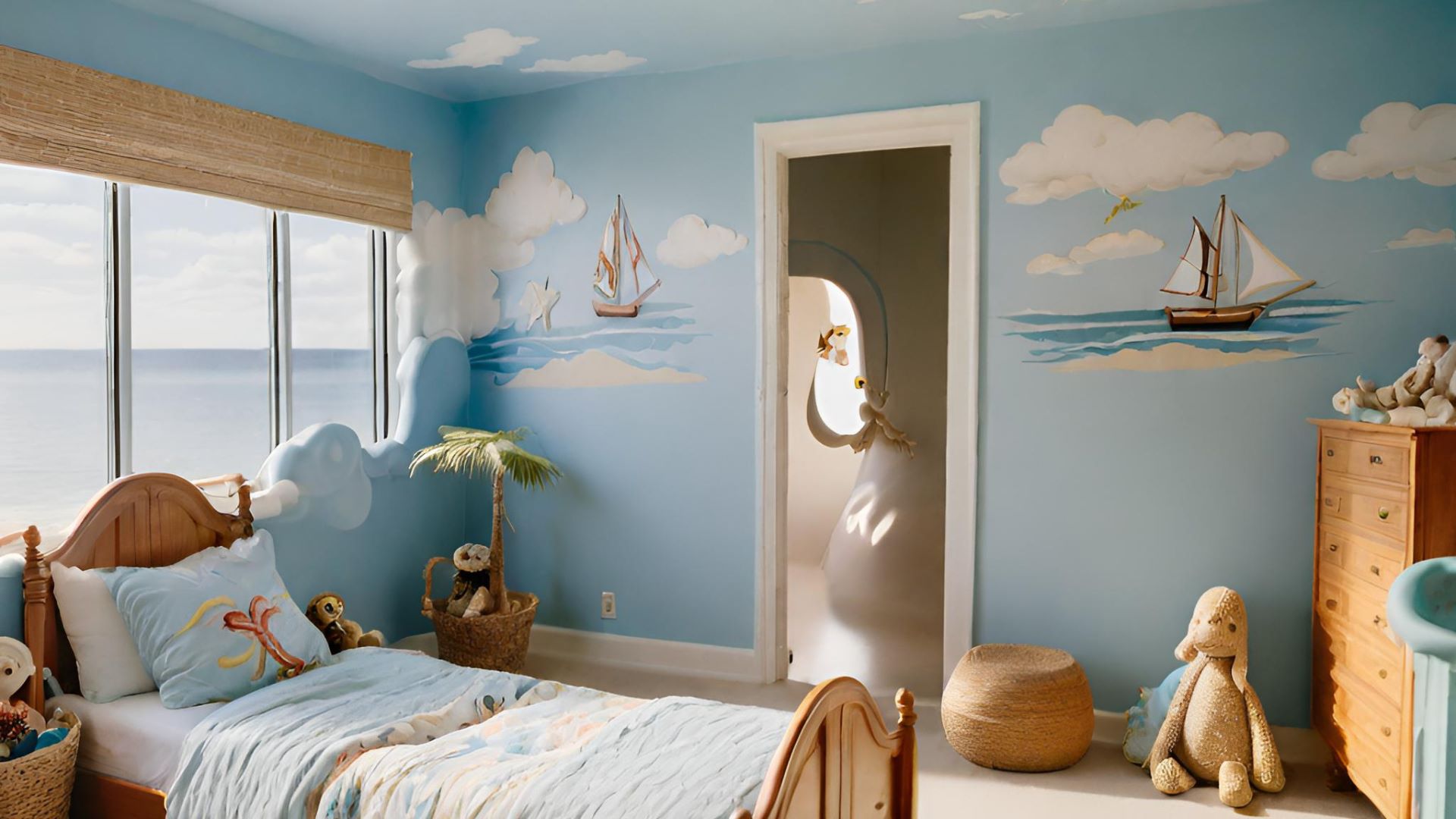Home>Create & Decorate>DIY & Crafts>Cabin Crafting: Building Your Own Rustic Retreat


DIY & Crafts
Cabin Crafting: Building Your Own Rustic Retreat
Published: February 24, 2024

Senior Editor in Create & Decorate, Kathryn combines traditional craftsmanship with contemporary trends. Her background in textile design and commitment to sustainable crafts inspire both content and community.
Discover the art of DIY & Crafts with Cabin Crafting. Learn how to build your own rustic retreat and unleash your creativity in the great outdoors. Start your crafting journey today!
(Many of the links in this article redirect to a specific reviewed product. Your purchase of these products through affiliate links helps to generate commission for Twigandthistle.com, at no extra cost. Learn more)
Introduction
Building your own rustic retreat in the form of a cozy cabin is a dream that many DIY enthusiasts and nature lovers share. The allure of creating a tranquil escape nestled amidst the beauty of the great outdoors is undeniably appealing. Whether you envision a quaint weekend getaway, a serene artist's studio, or a peaceful retirement haven, the process of crafting your own cabin is an immensely rewarding endeavor.
Embarking on the journey of constructing a cabin allows you to channel your creativity and craftsmanship into a tangible, functional space that reflects your unique vision. From selecting the perfect location to choosing the right materials and tools, every step of the process presents an opportunity to infuse your personal touch and bring your dream cabin to life.
As you delve into the world of cabin crafting, you'll find yourself immersed in a blend of practical construction techniques and the art of harmonizing your retreat with its natural surroundings. The satisfaction of witnessing your cabin take shape, from laying the foundation to adding the finishing touches, is unparalleled. Each nail driven and board secured brings you closer to the realization of your rustic sanctuary.
Throughout this guide, we will explore the essential steps and considerations involved in building your own cabin. From the initial planning stages to the final details, you'll gain valuable insights into the intricacies of cabin construction. By the end of this journey, you'll be equipped with the knowledge and inspiration to embark on your own cabin-building adventure, ready to transform your vision into a tangible haven of tranquility and comfort.
Read more: DIY Rustic Bathroom Ideas
Choosing the Right Location
Selecting the perfect location for your cabin is a pivotal decision that significantly influences the overall experience of your rustic retreat. The ideal setting harmoniously blends natural beauty, accessibility, and practical considerations. Here's a comprehensive guide to help you navigate this crucial step:
-
Scenic Surroundings: Seek out a location that offers breathtaking natural scenery. Whether it's nestled amidst towering pines, overlooking a tranquil lake, or perched on a mountainside, the surroundings should evoke a sense of serenity and awe.
-
Accessibility: Consider the accessibility of the location, especially in relation to your intended use of the cabin. If it's a weekend getaway, a location within a few hours' drive from your primary residence may be ideal. For a retirement haven, accessibility to essential amenities and healthcare facilities becomes paramount.
-
Legal and Zoning Regulations: Research local zoning regulations and building codes to ensure that your chosen location allows for the construction of a cabin. Understanding these regulations beforehand can prevent potential setbacks and ensure a smooth building process.
-
Environmental Impact: Assess the environmental impact of your chosen location. Consider factors such as soil stability, drainage patterns, and the presence of protected flora and fauna. Additionally, evaluate the potential impact of your cabin on the surrounding ecosystem and strive to minimize any adverse effects.
-
Sunlight and Wind Exposure: Take note of the sun's path throughout the day and the prevailing wind patterns. Optimizing sunlight exposure can enhance energy efficiency, while understanding wind patterns is crucial for positioning the cabin to minimize exposure to harsh winds.
-
Water Source: If your ideal location doesn't have access to a municipal water supply, consider the availability of a reliable water source. Whether it's a nearby stream, well, or rainwater harvesting system, ensuring access to clean water is essential for a sustainable and self-sufficient retreat.
-
Privacy and Tranquility: Prioritize privacy and tranquility when selecting the location. The allure of a cabin lies in its ability to provide a peaceful escape from the hustle and bustle of everyday life. Choose a location that offers a sense of seclusion and tranquility, allowing you to immerse yourself in the soothing embrace of nature.
By carefully considering these factors, you can identify a location that not only accommodates your practical needs but also resonates with your vision of an idyllic rustic retreat. The chosen location will serve as the canvas upon which your cabin crafting journey unfolds, setting the stage for a harmonious integration of your sanctuary with the natural world.
Designing Your Cabin
Designing your cabin is a pivotal phase that lays the foundation for the entire construction process. It's the stage where your vision takes shape, blending practical considerations with aesthetic elements to create a space that resonates with your unique style and functional needs.
Embracing Rustic Charm
The design of your cabin should reflect the timeless allure of rustic architecture while accommodating modern comforts. Embrace the charm of exposed wooden beams, cozy fireplaces, and inviting porches that invite you to unwind and connect with nature. Consider incorporating elements such as reclaimed wood, natural stone, and ample natural light to infuse your cabin with a warm and inviting ambiance.
Functional Layout
Craft a functional layout that optimizes the use of space while maintaining a seamless flow throughout the cabin. Whether you envision an open-concept design for communal areas or cozy nooks for solitude, the layout should cater to your specific lifestyle and preferences. Factor in essential amenities such as a well-equipped kitchen, comfortable sleeping quarters, and a thoughtfully designed bathroom to ensure a harmonious blend of practicality and comfort.
Read more: DIY Western Room Decor Ideas
Sustainable Features
Integrate sustainable features into your cabin's design to minimize environmental impact and enhance self-sufficiency. Explore options such as energy-efficient windows, solar panels, and passive heating and cooling techniques to align your retreat with eco-friendly principles. By prioritizing sustainability in the design phase, you can create a cabin that not only treads lightly on the environment but also offers long-term cost savings.
Harmonizing with Nature
Ensure that your cabin's design harmonizes with its natural surroundings, creating a seamless transition between the interior and the outdoor environment. Incorporate large windows to frame picturesque views, and consider outdoor living spaces that invite you to savor the beauty of the surrounding landscape. By blurring the boundaries between the interior and exterior, your cabin becomes a tranquil sanctuary that celebrates the splendor of nature.
Personal Touches
Infuse your cabin's design with personal touches that reflect your individuality and passions. Whether it's handcrafted furniture, curated artwork, or cherished mementos, these elements add character and depth to your retreat. Embrace the opportunity to showcase your creativity and create a space that feels uniquely yours, evoking a sense of comfort and nostalgia with every detail.
As you embark on the design phase of your cabin crafting journey, let your imagination soar while grounding your vision in practicality and sustainability. By thoughtfully designing your cabin, you set the stage for a harmonious blend of rustic charm, modern comfort, and a deep connection to the natural world.
Selecting Materials and Tools
Selecting the right materials and tools is a crucial step in the cabin crafting process, laying the groundwork for the structural integrity, aesthetic appeal, and longevity of your rustic retreat. From sturdy lumber to precision tools, each component plays a pivotal role in bringing your cabin from concept to reality.
Read more: How To Build A Small Cabin
Lumber and Timber
The selection of lumber and timber forms the backbone of your cabin's construction. Opt for high-quality, durable wood species such as cedar, pine, or spruce, known for their resilience and natural beauty. Consider the specific requirements of each structural element, from load-bearing beams to exterior cladding, and choose materials that strike a balance between strength and visual appeal.
Foundation Materials
The foundation of your cabin demands materials that provide stability and protection against moisture and shifting soil. Concrete blocks, poured concrete, or treated wooden posts are common choices for cabin foundations, each offering distinct advantages in terms of cost, durability, and ease of installation. Evaluate the soil composition and drainage patterns of your chosen location to determine the most suitable foundation materials for your cabin.
Roofing and Insulation
Select roofing materials that offer reliable protection against the elements while complementing the aesthetic of your cabin. Options such as metal roofing, asphalt shingles, or cedar shakes present varying degrees of durability and visual appeal. Additionally, prioritize high-quality insulation to ensure energy efficiency and climate control within your cabin, enhancing comfort and reducing long-term energy costs.
Essential Tools
Equipping yourself with the right tools is essential for executing the construction process with precision and efficiency. From power tools such as circular saws, drills, and nail guns to hand tools including hammers, chisels, and levels, assembling a comprehensive toolkit empowers you to tackle each phase of cabin construction with confidence. Prioritize safety equipment such as goggles, gloves, and dust masks to safeguard yourself during the building process.
Read more: DIY Rustic Basement Ideas
Sustainable and Eco-Friendly Options
Consider incorporating sustainable and eco-friendly materials into your cabin construction, aligning with principles of environmental responsibility. Explore options such as reclaimed wood, recycled composite decking, and low-VOC paints and finishes to minimize environmental impact and promote a greener approach to cabin crafting. By prioritizing sustainable materials, you can create a retreat that resonates with eco-conscious values.
Aesthetic Details
Beyond structural considerations, pay attention to the aesthetic details that contribute to the character and charm of your cabin. Select hardware, fixtures, and finishes that complement the rustic ambiance, whether it's wrought iron hinges, handcrafted door handles, or natural stone accents. These subtle yet impactful details elevate the visual appeal of your cabin, infusing it with a timeless and inviting allure.
By thoughtfully selecting materials and tools that align with your vision and values, you lay a solid foundation for the construction of a cabin that embodies craftsmanship, sustainability, and enduring beauty. Each material and tool chosen becomes a building block in the creation of your rustic retreat, shaping a space that harmonizes with its natural surroundings and reflects your unique style.
Building the Foundation
The foundation of a cabin serves as the bedrock upon which the entire structure rests, providing stability, support, and protection against the elements. Building a solid foundation is a critical step in the construction process, ensuring the long-term structural integrity and durability of your rustic retreat.
Site Preparation
Before laying the foundation, thorough site preparation is essential to create a stable and level base for the cabin. Clear the area of any vegetation, rocks, and debris, and meticulously level the ground to eliminate any unevenness. Proper site preparation sets the stage for a smooth and precise foundation construction process.
Read more: DIY Garage Bar Ideas: Transform Your Space
Foundation Types
Several foundation options are commonly used for cabin construction, each offering distinct advantages based on the specific requirements of the site and the cabin design. Concrete slab foundations provide a solid, low-maintenance base, while pier and beam foundations offer flexibility in accommodating uneven terrain. Additionally, full basement foundations provide ample storage and living space, ideal for larger cabins.
Material Selection
Selecting the right materials for the foundation is crucial to ensure resilience against moisture, soil movement, and structural loads. Treated lumber, concrete blocks, or poured concrete are commonly used for cabin foundations, offering durability and protection against environmental factors. Consider the soil composition and drainage patterns of the site to determine the most suitable foundation materials for long-term stability.
Construction Process
The construction of the foundation involves meticulous attention to detail and adherence to structural requirements. Whether pouring a concrete slab, setting concrete blocks, or installing support beams, precision is paramount to ensure a level and structurally sound foundation. Additionally, incorporating proper drainage measures and insulation during the foundation construction process contributes to the overall functionality and longevity of the cabin.
Environmental Considerations
When building the foundation, it's essential to consider the environmental impact and sustainability of the construction process. Minimizing disturbance to the natural landscape, implementing erosion control measures, and utilizing eco-friendly foundation materials align with principles of environmental responsibility. By prioritizing environmental considerations, the foundation construction becomes a harmonious integration of the cabin with its natural surroundings.
Read more: Rustic Farmhouse Bathroom Decor Ideas
Future Expansion and Adaptability
Anticipating future expansion or modifications to the cabin is integral to the foundation construction process. Designing the foundation to accommodate potential additions or alterations ensures adaptability and flexibility for evolving needs. Whether it's incorporating additional piers for future expansions or designing a basement foundation with expansion in mind, forward-thinking foundation construction sets the stage for the cabin's long-term versatility.
Building the foundation of your cabin is a foundational step that sets the tone for the entire construction process. By approaching this phase with meticulous planning, attention to detail, and a commitment to structural integrity, you establish a solid groundwork for the realization of your rustic retreat.
Constructing the Walls and Roof
Constructing the walls and roof of your cabin marks a pivotal phase in the journey of bringing your rustic retreat to life. This stage embodies the transformation of your vision into tangible form, as the structural elements take shape to define the character and resilience of your cabin.
Framing the Walls
The process begins with framing the walls, a fundamental step that lays the framework for the entire structure. Whether opting for traditional stud framing or alternative methods such as timber framing, precision and attention to detail are paramount. Each stud, beam, and brace plays a crucial role in establishing the structural integrity of the walls, ensuring stability and longevity for your cabin.
Selecting Exterior Cladding
Choosing the exterior cladding for your cabin involves a blend of practical considerations and aesthetic preferences. Whether embracing the timeless appeal of cedar siding, the durability of fiber cement panels, or the rustic charm of log cladding, the exterior material sets the tone for the visual identity of your cabin. Beyond visual appeal, the cladding serves as a protective barrier, shielding the cabin from the elements while contributing to its overall insulation and weather resistance.
Read more: How to Build a DIY Barn Door Cabinet
Roofing Installation
The installation of the roof is a defining moment in the construction process, as it encapsulates the sheltering embrace of your cabin. Selecting the right roofing material, whether it's classic asphalt shingles, durable metal panels, or natural cedar shakes, is essential for ensuring long-term protection against rain, snow, and harsh sunlight. The roof installation demands precision and meticulous attention to waterproofing details, ensuring that your cabin remains a secure and weather-resistant haven.
Embracing Energy-Efficient Design
Incorporating energy-efficient design principles into the construction of the walls and roof can significantly enhance the sustainability and comfort of your cabin. From optimizing insulation to strategically positioning windows for natural light and passive heating, thoughtful design choices contribute to reduced energy consumption and long-term cost savings. By prioritizing energy efficiency, your cabin becomes a beacon of sustainable living amidst the natural landscape.
Harmonizing with the Surroundings
As the walls and roof take form, consider how their design harmonizes with the surrounding environment. Whether it's blending the cabin seamlessly into the forested landscape or creating a striking contrast against a backdrop of open meadows, the visual integration of your cabin with its surroundings adds depth and resonance to the overall aesthetic. By embracing the natural palette and architectural vernacular of the locale, your cabin becomes an organic extension of the landscape.
Crafting a Shelter of Tranquility
The construction of the walls and roof represents the convergence of craftsmanship, functionality, and aesthetic expression. Each nail driven and shingle laid brings you closer to the realization of a shelter that embodies the essence of tranquility and comfort. As the walls rise and the roof takes shape, your cabin transcends the realm of construction, evolving into a sanctuary that beckons you to embrace the serenity of nature within its welcoming embrace.
By approaching the construction of the walls and roof with meticulous care and a reverence for the art of cabin crafting, you set the stage for the emergence of a rustic retreat that stands as a testament to your vision and dedication.
Read more: How To Build A Log Cabin
Installing Windows and Doors
The installation of windows and doors in your cabin holds a pivotal role in shaping both its aesthetic appeal and functional efficiency. These apertures serve as gateways that seamlessly connect the interior space with the natural splendor outside, while also contributing to the overall insulation, ventilation, and security of the cabin.
Selecting the Right Windows
Choosing the right windows involves a thoughtful balance between aesthetic preferences and practical considerations. Opt for windows that not only complement the architectural style of your cabin but also offer energy efficiency and durability. Consider factors such as the orientation of the windows to maximize natural light, the framing material, and the type of glazing to ensure optimal insulation and climate control.
Embracing Natural Light
Strategically positioning windows to welcome an abundance of natural light into your cabin can transform the interior ambiance, creating a sense of warmth and spaciousness. Whether it's expansive picture windows that frame breathtaking views or strategically placed skylights that invite the sun's gentle rays, harnessing natural light enhances the visual allure and energy efficiency of your retreat.
Ensuring Ventilation and Airflow
In addition to welcoming light, windows play a crucial role in facilitating ventilation and airflow within the cabin. Consider incorporating operable windows that allow for adjustable airflow, promoting cross ventilation to maintain a fresh and comfortable indoor environment. Balancing natural ventilation with energy efficiency contributes to a harmonious and healthful living space.
Read more: DIY Enchanted Forest Bedroom Ideas
Securing the Cabin with Doors
Selecting doors that offer security, weather resistance, and aesthetic appeal is essential for creating a welcoming and secure entryway to your cabin. Whether opting for the timeless charm of a solid wood door, the durability of fiberglass, or the low maintenance of steel, the choice of material and design should align with the overall character of your rustic retreat while providing reliable protection and insulation.
Enhancing Indoor-Outdoor Connectivity
The installation of doors extends beyond mere functionality, serving as a bridge that seamlessly connects the interior living spaces with the outdoor surroundings. Consider incorporating sliding glass doors, French doors, or a welcoming front porch to encourage a fluid transition between the cozy interior and the natural beauty outside. This integration blurs the boundaries between indoor and outdoor living, inviting you to savor the tranquility of nature from within the comfort of your cabin.
Infusing Character and Charm
Beyond their practical functions, windows and doors present an opportunity to infuse your cabin with character and charm. Consider embellishments such as decorative window grilles, custom hardware, or handcrafted wooden doors to add a touch of artisanal craftsmanship and individuality to your retreat. These details contribute to the overall aesthetic appeal, creating a sense of timeless elegance and inviting warmth.
The installation of windows and doors represents a transformative phase in the construction of your cabin, where the convergence of practicality and aesthetics shapes a space that resonates with comfort, security, and natural beauty. As each window is carefully fitted and each door is thoughtfully hung, your cabin evolves into a haven that beckons you to embrace the serenity of the great outdoors from within its welcoming embrace.
Adding Finishing Touches
As the construction of your cabin nears completion, the stage is set for the transformative process of adding the finishing touches. This phase represents the culmination of your vision, where every detail contributes to the overall ambiance, functionality, and aesthetic appeal of your rustic retreat.
Read more: DIY Farmhouse Bedroom Makeover
Interior Design Harmony
Infusing the interior spaces with a harmonious blend of furnishings, textiles, and decor elements elevates the ambiance of your cabin. Embrace the rustic charm of handcrafted furniture, cozy textiles, and inviting accents that reflect the natural beauty of the surroundings. Consider incorporating elements such as reclaimed wood accents, soft textiles in earthy tones, and nature-inspired artwork to create a welcoming and serene interior environment.
Lighting and Ambiance
Thoughtfully designed lighting plays a pivotal role in setting the mood and enhancing the functionality of your cabin. Explore a combination of natural light, ambient lighting fixtures, and task lighting to create a versatile and inviting atmosphere. Whether it's the warm glow of pendant lights over a dining area or strategically placed floor lamps for reading nooks, lighting contributes to the overall comfort and visual allure of your retreat.
Functional Amenities
Incorporating essential amenities such as a well-equipped kitchen, a cozy fireplace, and a thoughtfully designed bathroom adds a layer of comfort and convenience to your cabin. Prioritize functional elements that align with your lifestyle, whether it's a spacious kitchen island for culinary pursuits, a wood-burning stove for cozy evenings, or a spa-like bathroom retreat that offers a tranquil escape.
Outdoor Living Spaces
Extend the allure of your cabin into the outdoor realm by creating inviting outdoor living spaces. Whether it's a spacious deck for al fresco dining, a tranquil patio for stargazing, or a fire pit for gathering under the night sky, outdoor spaces provide an extension of the cabin's comfort and charm. Consider incorporating comfortable seating, natural landscaping, and ambient lighting to craft outdoor retreats that beckon you to savor the beauty of the natural surroundings.
Read more: How to Build a Pallet Bathroom Vanity
Personal Flourishes
Infuse your cabin with personal touches that reflect your passions and experiences. Whether it's displaying cherished mementos, incorporating handcrafted elements, or showcasing artwork that resonates with your soul, these personal flourishes add depth and character to your retreat. Embrace the opportunity to curate a space that feels uniquely yours, evoking a sense of nostalgia and comfort with every detail.
Sustainable Practices
Incorporate sustainable practices into the final details of your cabin, aligning with principles of environmental responsibility. From selecting eco-friendly finishes and furnishings to implementing water-saving fixtures and energy-efficient appliances, prioritizing sustainability adds a layer of conscientious living to your retreat. By embracing sustainable practices, your cabin becomes a testament to mindful living within the natural landscape.
As you add the finishing touches to your cabin, each detail becomes a brushstroke in the canvas of your retreat, shaping a space that resonates with warmth, tranquility, and timeless allure. From the interior harmony to the outdoor embrace, every element contributes to the creation of a rustic sanctuary that invites you to immerse yourself in the beauty of nature within its welcoming embrace.
Conclusion
As the final nail is driven and the last detail falls into place, the culmination of your cabin crafting journey unfolds into a testament of dedication, creativity, and a deep connection to the natural world. The completion of your rustic retreat marks the realization of a dream—a tranquil haven nestled amidst the embrace of nature, reflecting your vision, craftsmanship, and unwavering passion for the art of cabin crafting.
Your journey began with the selection of the perfect location, a canvas upon which your sanctuary would take shape. The scenic surroundings, accessibility, and environmental considerations guided your choice, ensuring that your cabin harmonizes with its natural setting while offering a peaceful escape from the demands of everyday life.
The design phase allowed your creativity to flourish, blending rustic charm with modern comfort and sustainability. From the functional layout to the incorporation of sustainable features, every decision reflected a harmonious balance of practicality and aesthetic appeal, shaping a space that resonates with warmth and timeless allure.
The meticulous selection of materials and tools laid the foundation for the structural integrity and enduring beauty of your cabin. Each component, from sturdy lumber to energy-efficient windows, became a building block in the creation of a retreat that embodies craftsmanship, sustainability, and a deep connection to the natural world.
As the walls rose and the roof took shape, your cabin transcended the realm of construction, evolving into a sanctuary that beckons you to embrace the serenity of nature within its welcoming embrace. The installation of windows and doors seamlessly connected the interior living spaces with the outdoor splendor, blurring the boundaries between indoor comfort and the natural beauty outside.
The addition of finishing touches infused your cabin with character, comfort, and a sense of personal connection. From the interior harmony to the outdoor embrace, every detail contributed to the creation of a rustic sanctuary that invites you to immerse yourself in the beauty of nature within its welcoming embrace.
As you stand amidst the tranquility of your completed cabin, you are not merely witnessing the fruition of a construction project; you are embracing the embodiment of a dream—a retreat that reflects your spirit, your values, and your unwavering reverence for the natural world. Your cabin stands as a testament to the transformative power of craftsmanship, the enduring allure of rustic living, and the timeless beauty of a sanctuary crafted with passion and purpose.






